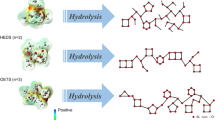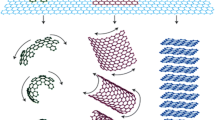Abstract
An organic–inorganic hybrid was prepared by simply mixing a fullerene derivative with polymethoxysiloxane. First, C60 was subjected to a radical addition reaction with 4,4′-azobis(4-cyanovaleric acid) to provide a C60 derivative. Polymethoxysiloxane was prepared by a controlled hydrolytic condensation of tetramethoxysilane. These two compounds were mixed and heated to provide hybrid bulk body. The hybrid bulk body showed high mechanical strength and elastic modulus compared with polymethoxysiloxane or the C60/polymethoxysiloxane hybrid. The formation of a dense siloxane network was established by a homogeneous mixing of the C60 derivative with polymethoxysiloxane.


Similar content being viewed by others

References
Tzirakis MD, Orfanopoulos M (2013) Radical reactions of fullerenes: from synthetic organic chemistry to materials science and biology. Chem Rev 113:5262–5321
Martin N, Giacalone F (2009) Fullerene polymers: synthesis, properties, and applications. Wiley, Weinheim
Martin N, Nierengarten J-F (2012) Supramolecular chemistry of fullerenes and carbon nanotubes. Wiley, Weinheim
Lai Y, Chiou W, Chiang L (1997) Fullerene derivatives attenuate bronchoconstriction induced by xanthine–xanthine oxidase. Fuller Sci Technol 5:1057–1065
IBM Corporation Japan Kokai Tokkyo Koho JP 1995-235045
Wang Y (1992) Photoconductivity of fullerene-doped polymers. Nature 356:585–587
Yoshino K, Xiao H, Muro K, Kiyomatsu S, Morita S, Zakihdov AA, Noguchi T, Ohnishi T (1993) Marked enhancement of photoconductivity and quenching of luminescence in poly(2,5-dialkoxy-p-phenylene vinylene) upon C60 doping. Jpn J Appl Phys 32:L357–L360
Kraabel B, McBranch D, Sariciftci N (1994) Ultrafast spectroscopic studies of photoinduced electron transfer from semiconducting polymers to C60. Phys Rev B 50:18543–18552
Murata K, Ito S, Takahashi K, Hoffman B (1996) Long-lived excited state of C60 in C60/phthalocyanine heterojunction solar cell. Appl Phys Lett 68:427–429
West R, Oka K, Takahashi H, Miller M, Gunji T (1994) Some silicon polymers of C60 (buckminsterfullerene): ACS symposium series 572 inorganic and organometallic polymers II advanced materials and intermediates. American Chemical Society, Washington, pp 92–101
Gunji T, Ozawa M, Abe Y, West R (2001) Preparation of C60-silica gel hybrid monolith by sol–gel process. J Sol–Gel Sci Technol 22:219–224
Gunji T, Sakai Y, Suyama Y, Arimitsu K, Abe Y (2004) Preparation and properties of C60-polysiloxane hybrids. J Sol–Gel Sci Technol 32:43–46
Gunji T, Sakai Y, Arimitsu K, Abe Y (2007) Preparation and properties of polyethoxysilsesquioxane-C60 hybrids. J Polym Sci Part A Polym Chem 45:3273–3279
West R, Gunji T, Oka K, Miller M, Wang Y (1994) Some C60 chemistry: hydrosilylation cyanopropylation and photoconductive complexes: fullerenes recent advances in the chemistry and physics of fullerenes and related materials. Electrochemical Society, Pennington, pp 1262–1267
Ford WT, Nishioka T, Qiu F, Souza F, D’Choi J, Kutner W, Noworyta K (1999) Structure determination and electrochemistry of products from the radical reaction of C60 with azo(bisisobutyronitrile). J Org Chem 64:6257–6262
Warren FT, Nishioka T, Qiu F, Souza F, D’Choi J (2000) Dimethyl azo(bisisobutyrate) and C60 produce 1,4- and 1,16-di(2-carbomethoxy-2-propyl)-1, x-dihydro[60]fullerenes. J Org Chem 65:5780–5784
Gunji T, Tozune T, Kaburaki H, Arimitsu K, Abe Y (2013) Preparation of co-polymethyl(alkoxy)siloxanes by acid-catalyzed controlled hydrolytic co-polycondensation of methyl(trialkoxy)silane and tetraalkoxysilane. J Polym Sci Part A Polym Chem 51:4732–4741
Hirsch A, Grösser T, Skiebe A, Soi A (1993) Synthesis of isomerically pure organodihydrofullerenes. Chem Ber 126:1061–1067
Acknowledgments
This work was supported by a Grant-in-Aid for Scientific Research on Innovative Areas “New Polymeric Materials Based on Element-Blocks (no. 2401)” (24102008A02) of The Ministry of Education, Culture, Sports, Science, and Technology, Japan.
Author information
Authors and Affiliations
Corresponding author
Rights and permissions
About this article
Cite this article
Gunji, T., Hirama, K., Tsukada, S. et al. Preparation and properties of a fullerene/polysiloxane hybrid from chemically modified fullerene and polymethoxysiloxane. J Sol-Gel Sci Technol 72, 80–84 (2014). https://doi.org/10.1007/s10971-014-3413-6
Received:
Accepted:
Published:
Issue Date:
DOI: https://doi.org/10.1007/s10971-014-3413-6



